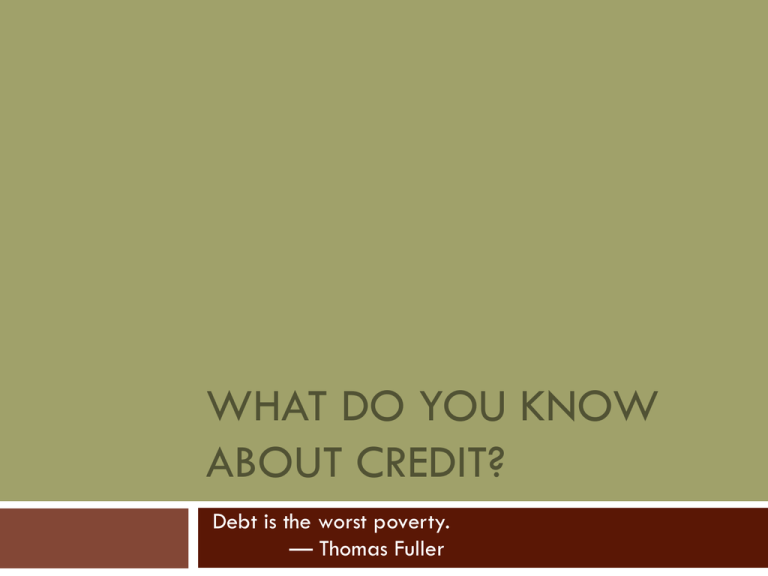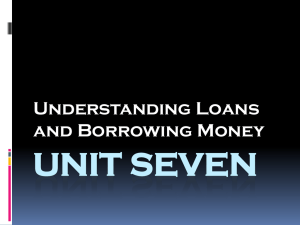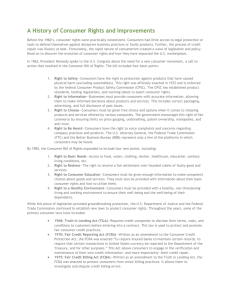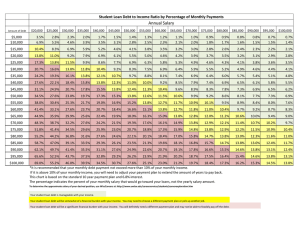WHAT DO YOU KNOW ABOUT CREDIT? Debt is the worst poverty.
advertisement

WHAT DO YOU KNOW ABOUT CREDIT? Debt is the worst poverty. — Thomas Fuller LifeSmarts is a program of the National Consumers League What is credit? 3 Borrowing money to use now with a promise and an obligation to pay it back later. How long have people used credit? 4 During the rein of Hammurabi (1792-1750 BC) the first regulations of interest, forgiveness of debt and extension of credit were developed. Merchants (and even temples, in some cases) made ordinary business loans, charging 20 percent for loans on silver, and 33.3 percent for loans on grain. Source: “The History of Credit and Debt by Steve Rhode”. Copyright 2000-2007, The Myvesta Foundation. All rights reserved. Why use credit? 5 What are some advantages of using credit? Advantages of using credit 6 You don’t need to carry cash. You have proof of purchase. A credit card statement is a record of your spending. Credit is convenient. Some additional advantages 7 Credit can provide emergency funds. A line of credit is a quick personal loan. Credit card companies will assist customers when there is a problem with a purchase. Credit allows the consumer to purchase big ticket items over time. You purchase goods and services with future income. Disadvantages of using credit 8 You purchase goods and services with future income. Finance charges and interest must be paid when you use someone else’s money. More disadvantages 9 It is easy to overspend because you are not using cash. It may encourage impulse buying. Credit card companies charge fees–late fees, over the limit fees, etc. Property can be repossessed if you do not pay. Using credit unwisely affects your credit rating. Identity theft is another issue 10 When you purchase with credit it is possible to have your credit card information stolen and used by someone else. This is one form of identity theft that affects millions of Americans each year. Are you familiar with these terms? 11 Dumpster diving Pretexting Phishing Skimming Dumpster diving 12 Thieves look through trash for documents that contain credit card information. This can happen at work, at home, or at a dump or waste management facility. Pretexting 13 You receive a request for your credit card information, or other personal information, from a source that might sound or look legitimate. The thief creates a “pretext,” or dishonest reason, for asking you for information. Phishing 14 You receive an email asking for personal information and you are sent to a look-alike Web page. These Web sites, that look identical to legitimate business sites, request your personal information and then use it for identity theft. Skimming 15 A thief attaches an electronic data storage device to an ATM or a retail point of sale terminal, steals your personal information, and uses your credit. Why offer credit? 16 With so many problems, why do businesses and financial institutions offer credit? It is really very simple 17 It is a service to their customers. It is one way they make money because you pay for the purchase and you pay interest and fees. Who qualifies for credit? 18 Most people who can meet the 3 C’s test. CHARACTER CAPITAL CAPACITY What do the 3 C’s have to do with it? 19 Character is your history of repaying debt. Do you pay the required amount? Do you pay on time? Capital, or assets – do you have possessions that could be sold to repay a creditor? Capacity is your income or earning power. Can you afford a debt? How much credit do you already have? What types of credit are available to the consumer? 20 Cash credit or a simple loan Sales credit, a 30-day charge account that must be paid in full at the end of the month Universal credit cards or bank cards Some other types of credit include: 21 INSTALLMENT or CLOSED CREDIT: A loan that you repay with fixed payments each month. OPEN OR REVOLVING CREDIT: You charge throughout the month and then receive a statement at the end of the billing cycle. One type of credit you may need: 22 A school loan for education after high school. Educational loans are a special category of credit and there are several types. Most often you do not have to pay interest until after you graduate from school. How can I know how much credit I can afford to use? 23 Credit experts advise the 20/10 Rule. Never spend more than 20% of your annual take-home pay for credit debt. Do not agree to monthly payments that are more than 10% of monthly take-home pay. Yes and No 24 “There are only two words that will always lead you to success. Those words are yes and no. Undoubtedly, you’ve mastered saying yes, so start practicing saying no. Your goals depend on it!” — Jack Canfield What are my credit rights? 25 Federal laws have been passed specifically to protect consumers who use credit. They are often referred to as acronyms. TILA FCRA FCBA ECOA FDCPA What do all those letters stand for? 26 TILA—Truth in Lending Act FCRA—Fair Credit Reporting Act FCBA—Fair Credit Billing Act ECOA—Equal Credit Opportunity Act FDCPA—Fair Debt Collection Practices Act The Federal Trade Commission 27 The Federal Trade Commission, or FTC, works for the consumer to prevent fraudulent, deceptive, and unfair business practices in the marketplace and to provide information to help consumers spot, stop, and avoid them. For additional information visit ftc.gov. Source: Federal Trade Commission-Bureau of Consumer Protection The Truth in Lending Act—TILA 28 Under this law creditors must disclose specific information in any offer they make to the consumer. Some of the information required by law includes: The APR Finance charges Minimum payment required Method used to compute interest Grace period Annual fee, if any Credit limit Fair Credit Reporting Act—FCRA 29 The federal Fair Credit Reporting Act promotes the accuracy and privacy of information in the files of the nation’s consumer reporting companies. Under the FCRA you have the right to receive a free copy of your credit report every year from each credit reporting agency. Equal Credit Opportunity Act—ECOA 30 ECOA prohibits credit discrimination. This means that creditors may not use sex, race, marital status, religion, national origin, age or the receipt of public assistance against you when deciding to grant credit. This law also requires that if you are denied credit you have a legal right to know why. Fair Credit Billing Act—FCBA 31 Covers the procedures for resolving mistakes and disputes on credit billing statements. Consumers should check billing statements carefully and when they find an error notify the company immediately. The FCBA generally applies only to open credit accounts and does not apply to closed or installment credit until the loan is paid in full. Fair Debt Collection Practices Act—FDCPA 32 According to the FTC this law requires that when you fall behind on your credit obligations the debt collector is required to treat you fairly. The law includes specific rules about when and how they may contact you. LifeSmarts Learn it. Live it. LifeSmarts is: •An educational program teaching teens and tweens important real-life knowledge •A competition – students compete online and in-person •A teaching toolbox. Check out our resources •An opportunity for students to gain leadership skills, and fulfill community service requirements •A chance to develop strong partnerships with national groups such as FBLA and FCCLA Visit LifeSmarts at www.lifesmarts.org





